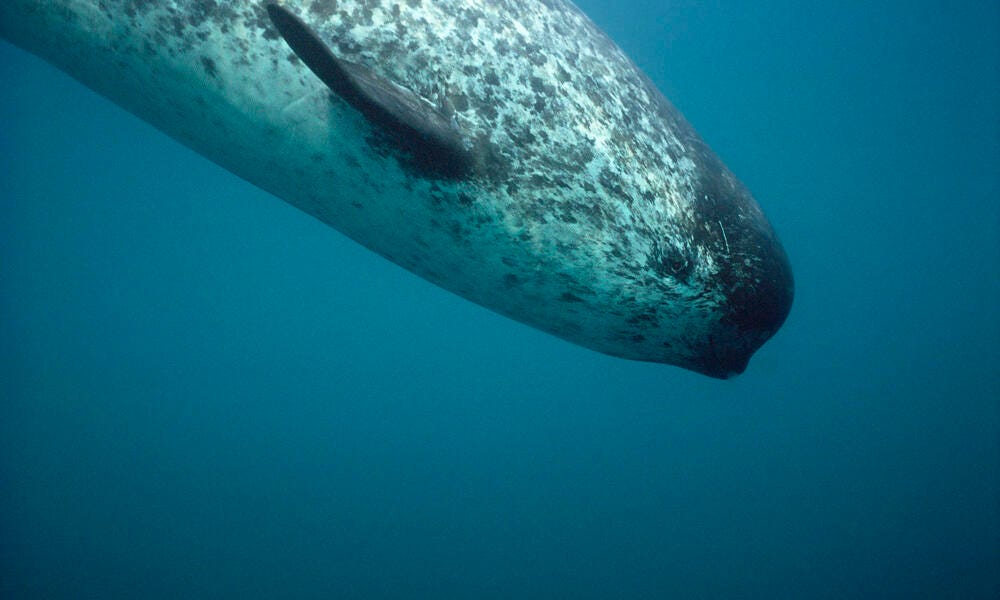Narwhals
The Unicorns of the Sea
In legend, Narwhals have been called the unicorns of the sea and with their long spiralling tusk you can see why. In fact, they are a toothed whale alongside other species such as dolphins, porpoises and any other whales with teeth, like the sperm whale. In total, there are 73 species of toothed whale, with all other whales being grouped into another category - baleen whales. The two groups are thought to have diverged from each other around 34 million years ago and both have since diverged into different genera. Narwhals are the only species in their genus but they share a family with one other whale - the beluga. Both species look fairly similar, both with big melons (the lumps of their head which help them to echolocate), short snouts and the absence of a dorsal fin which allows them to swim under the ice. Both species also have jointed neck vertebrae which allows them to look left and right, something which is uncommon amongst whales. The major difference is the huge tusk that is sticking out from the narwhals head, which I am sure the belugas are quite jealous of.


Narwhals have the scientific name Monodon monoceros - which translated from Greek is single-toothed, single-horn. They definitely have more than one tooth but apart from that, it gets across the idea. Their common name comes from an Old Norse word meaning corpse whale, which might refer to their deathly colouring or the fact they often ‘log’ under the water, meaning they just float in one position. Only male Narwhals have the horn (which can reach a colossal 9ft 10 inches!) , and it has been long debated what it is actually used for. The fact that only the males have it, and based on the reasoning that their life expectancy is lower than the females, suggests that there is no survival benefit to it and it might just be to make the males attractive, evolving under the pressures of sexual selection. The tusk might be useful for males to use in fighting over mating although some people have suggested it could be used in hunting. The tusk leads to many nerve sensors and so it may allow the narwhal to gauge the water temperature and other environmental conditions. They are a migratory species, leaving the pack ice to travel to shallower summer waters to give birth. They are among the deepest diving whales, especially when they return to the deeper northern waters in the winter, where they hunt cod, halibut, shrimp and squid. During this time, they rely on holes in the sea ice to breath, but spend much of their time under water hiding from predators such as polar bears and orcas.
Their colour changes across their lifetime, as they become whiter as they get older. And they get very - very - old, with females living on average to be 115. Males die younger, at around 84. During this long life, they can grow up to be 18ft long. Due to their long lives, Narwhals are one of the only mammals to go through the menopause and older females have a role in protecting young calves even after their own reproductive window has passed. Narwhals live in groups of between 3 and 8 individuals and these can be nursery groups made up of females and calves or bachelor groups made up of males - or a mix of the two. Females are pregnant for 15 months and give birth to a massive 4.9ft baby. The baby relies on its mother milk for another 20 months, giving it time to learn crucial survival skills for its hopefully long life. They are very vocal animals, communicating with a series of clicks between and within groups and using echolocation to locate their prey. It is suspected that groups and individuals have different calls, suggesting that they are using different ‘languages’ or using specific names.
Despite Narwhals still being classed as of least concern on the IUCN red list, they face a variety of threats including commercial hunting, their vocalisations being disturbed by oil exploration, and climate change. Narwhals rely heavily on sea ice for all parts of their life and its loss is going to be incredibly harmful for the species. They also suffer as a result of bioaccumulation (accumulating pollutants, such as heavy metals) as they are near the top of the food chain. This will damage the species for generations to come. Narwhals are of vital importance, both in their ecosystem and as a cultural symbol and resource for some indigenous groups, like the Inuit people. It is crucial that people don’t just assume that they will be ok because their numbers aren’t dangerously low now and instead take steps to ensure their continued survival.
There is so much to know about narwhals away from their tusks. But I’m sure they wouldn’t mind if they knew how amazing we find them. You don’t have a tusk like that not to show it off and impress people. And I think we are all pretty impressed. I mean, imagine having to cart around a 9ft 10 pole on your face. But I think we should be equally impressed by the females who manage to evade predators, migrate long distances and protect the next generation for 115 years. I would say that is a harder task than just carrying around a little tusk!




